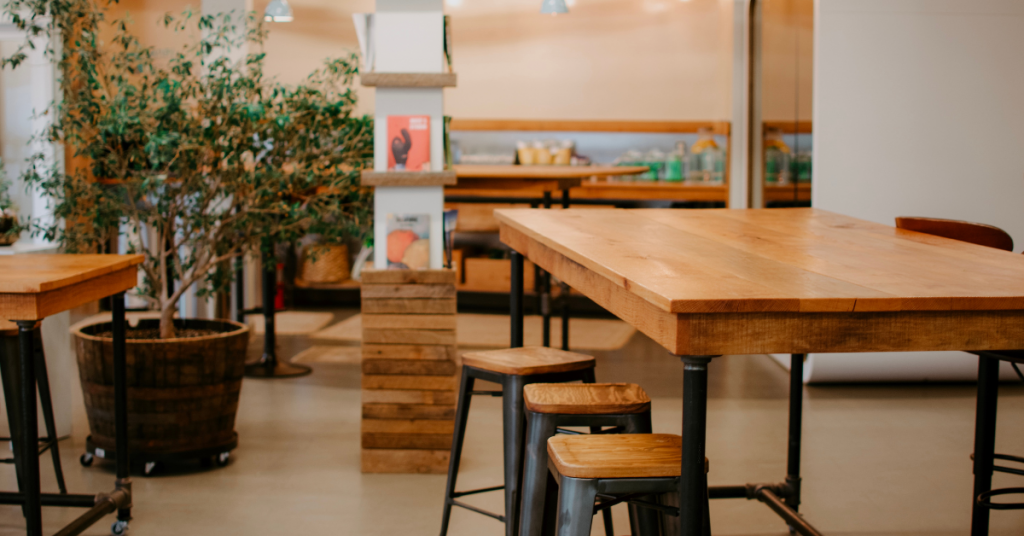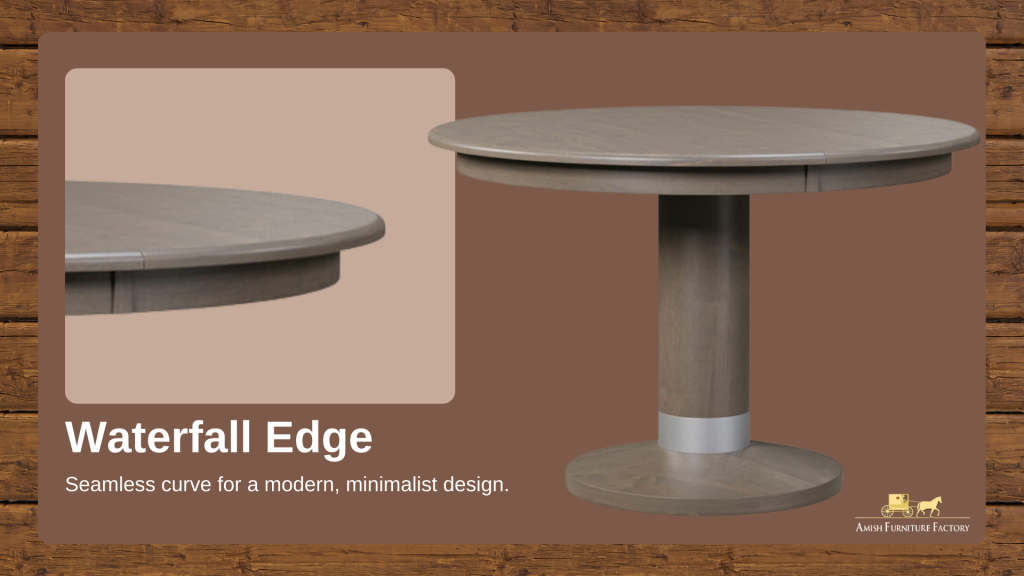
When selecting a dining table or any other piece of furniture, one of the most overlooked yet impactful details is the edge profile. The shape and style of table edges can influence not only its overall appearance but also its functionality and safety. Whether you’re furnishing a modern minimalist space or a traditional dining room, understanding the different table edge profiles can help you make a more informed decision.
Key Takeaways
- Selecting the right edge profile for your table can significantly impact both the style and functionality of your dining space.
- Consider factors like room aesthetics, safety, and ease of maintenance to find the perfect match.
- Your choice of edge profile should reflect your personal taste and how you envision the table fitting into your space. This ensures that the table not only serves its functional purpose but also aligns with your aesthetic preferences.
This guide will walk you through the various options, factors to consider, and how to match the edge profile to your table material, ensuring that your choice is both beautiful and practical.
What is a Table Edge Profile and Why it Matters
A table edge profile is the shape of the table’s edges. It affects the table’s look and how it functions. The right edge profile can either blend in with the room or stand out as a focal point. It also impacts comfort, safety, and maintenance. Choosing the right profile helps create a balanced and attractive look that fits your style and room.
Here’s a video talking more about dining table edge options:
Mission Edge

The Mission Edge is a simple and straightforward profile, characterized by its straight lines and sharp edges. It’s often used in traditional or craftsman-style furniture, providing a clean and sturdy appearance. This edge profile emphasizes function over form, making it a practical choice for tables that need to withstand heavy use. Its minimalistic design ensures that it can blend seamlessly with a variety of interior styles, particularly those that favor understated elegance.
Chamfer Edge

A Chamfer Edge features a beveled cut along the top edge of the table, creating a subtle angle. This profile is often chosen for its comfort, as the rounded edge is less likely to cause injury and feels pleasant to the touch. It’s a great choice for family dining room tables or any setting where safety and comfort are priorities. The gentle curve also adds a subtle elegance to the table’s overall design.
Full Thumbnail Edge

The Full Thumbnail Edge has a rounded, convex shape that resembles a thumb’s curve, giving the table a soft and smooth look. This profile is often chosen for its comfort, as the rounded edge is less likely to cause injury and feels pleasant to the touch. It’s a great choice for family dining tables or any setting where safety and comfort are priorities. The gentle curve also adds a subtle elegance to the table’s overall design.
Bevel Edge

The Bevel Edge is characterized by a sharp, angled cut that tapers the edge of the table, giving it a sleek and refined look. This profile is often used in modern or contemporary designs where clean lines and straight edges are favored. The bevel edge adds a dynamic quality to the table, making it stand out without being overly dramatic. It’s also practical, as the angled edge can help reduce the appearance of wear and tear over time.
45 Degree Chamfer Edge

Similar to the Chamfer Edge, the 45 Degree Chamfer Edge features a more pronounced angled cut, typically at a 45-degree angle. This profile adds a modern and geometric touch to the table, making it a popular choice for contemporary designs. The sharper angle creates a bold statement, giving the table a distinct and edgy appearance. Despite its striking look, it remains functional and can be paired with various table styles and materials.
Half Inch Roundover Edge
The Half Inch Roundover Edge has a gently rounded curve that extends about half an inch along the table’s edge. This profile is favored for its soft, smooth edge, making it comfortable to lean against or touch. It’s a versatile choice that works well in casual and formal settings alike. The rounded edge also helps protect against bumps and injuries, making it a practical option for family dining room tables or workspaces.
Ogee Edge

The Ogee Edge is an ornate profile that features an “S” shaped curve, combining concave and convex lines. This edge profile is often associated with traditional or classic table edge designs, adding a touch of elegance and sophistication to the table. The detailed curvature of the ogee edge makes it a standout feature, especially in formal dining rooms or spaces where a more luxurious look is desired. It’s a great choice for tables that serve as a focal point in the room.
Waterfall Edge

The Waterfall Edge features a continuous curve that smoothly transitions from the tabletop to the sides, resembling a cascading waterfall. This profile is sleek and modern, often used in contemporary or minimalist designs. The seamless curve gives the table a fluid and organic appearance, making it a visually appealing option. The waterfall edge also emphasizes the beauty of the table’s material, as the unbroken line highlights the grain and texture.
Traditional Thumbnail Edge

The Traditional Thumbnail Edge is similar to the Full Thumbnail Edge but with a more defined and sharper curve. This profile combines a rounded edge with a slight step detail, adding a subtle yet classic table edge touch to the table. It’s a versatile choice that works well in both traditional and transitional designs, offering a blend of comfort and style. The traditional thumbnail edge provides a timeless look that can complement a variety of interior styles.
Factors to Consider When Choosing an Edge Profile

When selecting a table edge profile, several factors can influence your decision. These include the overall style of the room, safety needs, maintenance requirements, personal preferences, and how the table will be used in your space.
Room Style and Aesthetic
Select an edge profile that enhances the overall style of your room. Modern spaces benefit from sleek profiles like Bevel or Waterfall, while traditional decor is complemented by classic profiles such as Mission or Ogee.
Safety and Durability
For homes with children, opt for rounded edges like Half Inch Roundover or Full Thumbnail to minimize injury risks. These profiles are also more durable and less likely to chip compared to sharp edges, making them both safer and longer-lasting.
Maintenance and Functionality
Choose profiles like Chamfer or Bevel for easy cleaning and maintenance. For smaller rooms, sleek profiles like 45 Degree Chamfer reduce visual bulk, while versatile profiles like Chamfer Edge provide practicality for various uses.
Personal Preference
Pick an edge profile that aligns with your personal style. Whether you prefer the elegance of Ogee or the simplicity of Mission, ensure the profile reflects your aesthetic preferences and enhances the final look of your furniture.
Discover the perfect edge of table design to enhance your dining experience. Visit Amish Dining Tables to explore our exquisite handcrafted options.
Conclusion
Choosing the right table edge profile is more than just a design choice—it’s about finding a balance between style, safety, functionality, and personal preference. Whether you prefer the sleek lines of a Chamfer Edge or the classic curves of an Ogee Edge, the perfect profile can enhance your table and complement your space. Remember, the table’s edge is a small detail that makes a big impact, so take the time to consider what suits your needs best.
FAQs
Can I customize the edge profile of my table?
Yes, many furniture makers, including the Amish Furniture Factory, offer the option to customize the edge profile of your table. This allows you to choose a design that perfectly matches your style and needs. Customization ensures that your table is truly unique and tailored to your space.
What is the best edge profile for a modern design?
For a modern design, sleek and clean edge profiles like the Bevel Edge or 45 Degree Chamfer Edge work best. These profiles add a contemporary touch and complement minimalist aesthetics. The Waterfall Edge is also a great choice for those who prefer smooth, continuous lines.
Are certain edge profiles safer for children?
Yes, rounded edge profiles like the Half Inch Roundover Edge or Full Thumbnail Edge are safer for homes with children. These profiles reduce the risk of injury from sharp corners, making them ideal for family dining tables or play areas. Safety without compromising style is key when selecting these edges.
How do I clean a live edge table?
To clean a live edge table, simply use a soft, damp cloth to wipe the surface, followed by a dry cloth to remove any moisture. Avoid harsh chemicals, as they can damage the natural finish. For deeper cleaning, consider using a wood-specific cleaner or polish to maintain the table’s beauty.
Can I combine different edge profiles on the same table?
Yes, it is possible to combine different edge profiles on the same table to create a unique look. This is often done to highlight specific design features or to create a more customized piece. However, it’s important to ensure that the profiles complement each other for a harmonious overall design.

